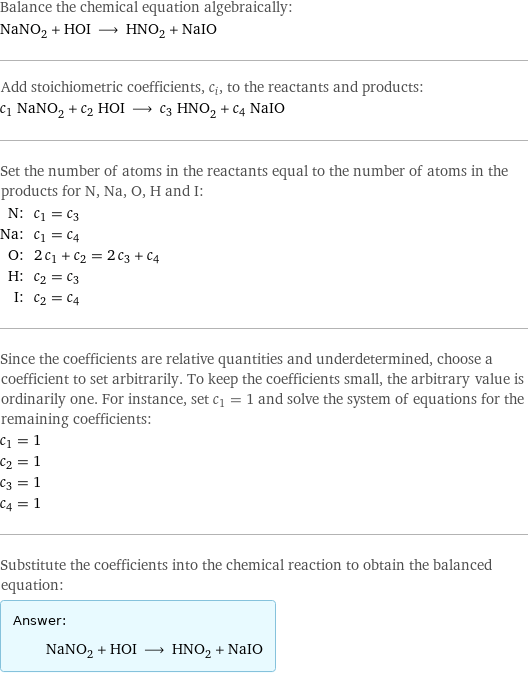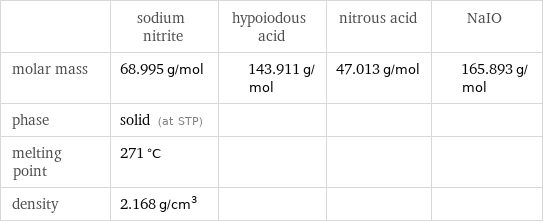Input interpretation

NaNO_2 sodium nitrite + HOI hypoiodous acid ⟶ HNO_2 nitrous acid + NaIO
Balanced equation

Balance the chemical equation algebraically: NaNO_2 + HOI ⟶ HNO_2 + NaIO Add stoichiometric coefficients, c_i, to the reactants and products: c_1 NaNO_2 + c_2 HOI ⟶ c_3 HNO_2 + c_4 NaIO Set the number of atoms in the reactants equal to the number of atoms in the products for N, Na, O, H and I: N: | c_1 = c_3 Na: | c_1 = c_4 O: | 2 c_1 + c_2 = 2 c_3 + c_4 H: | c_2 = c_3 I: | c_2 = c_4 Since the coefficients are relative quantities and underdetermined, choose a coefficient to set arbitrarily. To keep the coefficients small, the arbitrary value is ordinarily one. For instance, set c_1 = 1 and solve the system of equations for the remaining coefficients: c_1 = 1 c_2 = 1 c_3 = 1 c_4 = 1 Substitute the coefficients into the chemical reaction to obtain the balanced equation: Answer: | | NaNO_2 + HOI ⟶ HNO_2 + NaIO
Structures

+ ⟶ + NaIO
Names

sodium nitrite + hypoiodous acid ⟶ nitrous acid + NaIO
Equilibrium constant
![Construct the equilibrium constant, K, expression for: NaNO_2 + HOI ⟶ HNO_2 + NaIO Plan: • Balance the chemical equation. • Determine the stoichiometric numbers. • Assemble the activity expression for each chemical species. • Use the activity expressions to build the equilibrium constant expression. Write the balanced chemical equation: NaNO_2 + HOI ⟶ HNO_2 + NaIO Assign stoichiometric numbers, ν_i, using the stoichiometric coefficients, c_i, from the balanced chemical equation in the following manner: ν_i = -c_i for reactants and ν_i = c_i for products: chemical species | c_i | ν_i NaNO_2 | 1 | -1 HOI | 1 | -1 HNO_2 | 1 | 1 NaIO | 1 | 1 Assemble the activity expressions accounting for the state of matter and ν_i: chemical species | c_i | ν_i | activity expression NaNO_2 | 1 | -1 | ([NaNO2])^(-1) HOI | 1 | -1 | ([HOI])^(-1) HNO_2 | 1 | 1 | [HNO2] NaIO | 1 | 1 | [NaIO] The equilibrium constant symbol in the concentration basis is: K_c Mulitply the activity expressions to arrive at the K_c expression: Answer: | | K_c = ([NaNO2])^(-1) ([HOI])^(-1) [HNO2] [NaIO] = ([HNO2] [NaIO])/([NaNO2] [HOI])](../image_source/71c65580ebce9de433d22b58007dc8b7.png)
Construct the equilibrium constant, K, expression for: NaNO_2 + HOI ⟶ HNO_2 + NaIO Plan: • Balance the chemical equation. • Determine the stoichiometric numbers. • Assemble the activity expression for each chemical species. • Use the activity expressions to build the equilibrium constant expression. Write the balanced chemical equation: NaNO_2 + HOI ⟶ HNO_2 + NaIO Assign stoichiometric numbers, ν_i, using the stoichiometric coefficients, c_i, from the balanced chemical equation in the following manner: ν_i = -c_i for reactants and ν_i = c_i for products: chemical species | c_i | ν_i NaNO_2 | 1 | -1 HOI | 1 | -1 HNO_2 | 1 | 1 NaIO | 1 | 1 Assemble the activity expressions accounting for the state of matter and ν_i: chemical species | c_i | ν_i | activity expression NaNO_2 | 1 | -1 | ([NaNO2])^(-1) HOI | 1 | -1 | ([HOI])^(-1) HNO_2 | 1 | 1 | [HNO2] NaIO | 1 | 1 | [NaIO] The equilibrium constant symbol in the concentration basis is: K_c Mulitply the activity expressions to arrive at the K_c expression: Answer: | | K_c = ([NaNO2])^(-1) ([HOI])^(-1) [HNO2] [NaIO] = ([HNO2] [NaIO])/([NaNO2] [HOI])
Rate of reaction
![Construct the rate of reaction expression for: NaNO_2 + HOI ⟶ HNO_2 + NaIO Plan: • Balance the chemical equation. • Determine the stoichiometric numbers. • Assemble the rate term for each chemical species. • Write the rate of reaction expression. Write the balanced chemical equation: NaNO_2 + HOI ⟶ HNO_2 + NaIO Assign stoichiometric numbers, ν_i, using the stoichiometric coefficients, c_i, from the balanced chemical equation in the following manner: ν_i = -c_i for reactants and ν_i = c_i for products: chemical species | c_i | ν_i NaNO_2 | 1 | -1 HOI | 1 | -1 HNO_2 | 1 | 1 NaIO | 1 | 1 The rate term for each chemical species, B_i, is 1/ν_i(Δ[B_i])/(Δt) where [B_i] is the amount concentration and t is time: chemical species | c_i | ν_i | rate term NaNO_2 | 1 | -1 | -(Δ[NaNO2])/(Δt) HOI | 1 | -1 | -(Δ[HOI])/(Δt) HNO_2 | 1 | 1 | (Δ[HNO2])/(Δt) NaIO | 1 | 1 | (Δ[NaIO])/(Δt) (for infinitesimal rate of change, replace Δ with d) Set the rate terms equal to each other to arrive at the rate expression: Answer: | | rate = -(Δ[NaNO2])/(Δt) = -(Δ[HOI])/(Δt) = (Δ[HNO2])/(Δt) = (Δ[NaIO])/(Δt) (assuming constant volume and no accumulation of intermediates or side products)](../image_source/173e42cf9f267f9e5b216bf49099f428.png)
Construct the rate of reaction expression for: NaNO_2 + HOI ⟶ HNO_2 + NaIO Plan: • Balance the chemical equation. • Determine the stoichiometric numbers. • Assemble the rate term for each chemical species. • Write the rate of reaction expression. Write the balanced chemical equation: NaNO_2 + HOI ⟶ HNO_2 + NaIO Assign stoichiometric numbers, ν_i, using the stoichiometric coefficients, c_i, from the balanced chemical equation in the following manner: ν_i = -c_i for reactants and ν_i = c_i for products: chemical species | c_i | ν_i NaNO_2 | 1 | -1 HOI | 1 | -1 HNO_2 | 1 | 1 NaIO | 1 | 1 The rate term for each chemical species, B_i, is 1/ν_i(Δ[B_i])/(Δt) where [B_i] is the amount concentration and t is time: chemical species | c_i | ν_i | rate term NaNO_2 | 1 | -1 | -(Δ[NaNO2])/(Δt) HOI | 1 | -1 | -(Δ[HOI])/(Δt) HNO_2 | 1 | 1 | (Δ[HNO2])/(Δt) NaIO | 1 | 1 | (Δ[NaIO])/(Δt) (for infinitesimal rate of change, replace Δ with d) Set the rate terms equal to each other to arrive at the rate expression: Answer: | | rate = -(Δ[NaNO2])/(Δt) = -(Δ[HOI])/(Δt) = (Δ[HNO2])/(Δt) = (Δ[NaIO])/(Δt) (assuming constant volume and no accumulation of intermediates or side products)
Chemical names and formulas

| sodium nitrite | hypoiodous acid | nitrous acid | NaIO formula | NaNO_2 | HOI | HNO_2 | NaIO Hill formula | NNaO_2 | HIO | HNO_2 | INaO name | sodium nitrite | hypoiodous acid | nitrous acid |
Substance properties

| sodium nitrite | hypoiodous acid | nitrous acid | NaIO molar mass | 68.995 g/mol | 143.911 g/mol | 47.013 g/mol | 165.893 g/mol phase | solid (at STP) | | | melting point | 271 °C | | | density | 2.168 g/cm^3 | | |
Units
